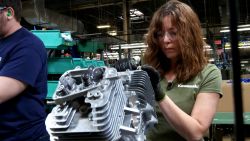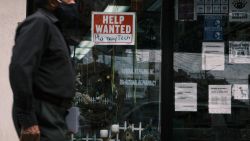As companies prepare to reopen and welcome employees back to the office, a big question remains: Are workers ready to come back?
Salesforce, a global enterprisesoftware company with more than 56,000 employees, is already getting a glimpse of what the future of work might look like. The company has reopened 22 offices around the world, including spaces in Sydney, Hong Kong, South Korea and Israel. This month, it plans to reopen its headquarters in San Francisco, along with two other California offices.
The company is taking a gradual approach to reopening, and carefully monitoring how its employees want to work and how they’re feeling about it. It’s also giving workers a choice of where they work: fully remote, office-based, or “flex” – where they’ll be in the office one to three days a week for more team and customer-based work.
“We’ve learned right away that our employees want a flexible environment,” said Brent Hyder, president and chief people officer.
The company increased the frequency of its employee surveys when the pandemic hit. At one point, there were daily well-being pulse surveys.Employees who have returned to the offices are surveyed weekly.
“Our employee behavior continues to change,” said Hyder. “You gotta listen deeply.”
Here’s what the company has learned so far:
The speed of return
Salesforce first started to reopen its offices in South Korea, Hong Kong, and China last year, but at first, employees were reluctant to return.
“They weren’t ready. They would come in one day a week or not at all,” said Hyder.
But as more time has passed, workers are becoming more comfortable with being in the office.
In Israel, where offices opened in April, employees are coming into the office at a much higher rate so far than any of the company’s other reopened offices, according to Hyder, but it is still at less than 50% capacity.
“We do think that Israel might be the trend in highly vaccinated markets,” Hyder said.

Offices are opening in a phased approached, and so far, employees are coming into the office for collaborative work and doing their individual work when they are remote.
In its Sydney office, which opened in August, around 24% of individual workspaces are booked on an average day, compared to more than 60% of the collaboration spaces, according to Hyder. And workers are coming into the office later in the week, with Thursday being the most popular day.
Before the pandemic, Renata Bertram, vice president of marketing, went into the Sydney office five days a week via public transportation.
“I started the process kicking and screaming working from home,” she said. But when the announcement came about the office reopening, she realized she had grown accustomed to the lifestyle that remote working allowed. “I thought: ”That’s great, but at the same time, are you kidding me? I am not going to be able to do my morning walks every day.’”
She eased in by going back into the office one day a week. “I had to build back that muscle,” she said. But she wasn’t comfortable taking the bus to get there andinstead drove.
She’s since settled into working in the office three days a week, and started commuting by bus again.
She recalled the office feeling a bit flat when she first returned, but noticed a change in the past few months.
“It’s been really fantastic … there is an energy and vibe. People are genuinely enjoying being in each others’ company,” she said.
Meet the new office
Salesforce’s employees aren’t walking back into the same spaces they left more than a year ago.
Before going into the office, employees complete a wellness check and schedule time to come into the office through the company’s online platform Work.com. The tool helps the company learn more about how employees are now using spaces.
“As we learn more and more about our offices and listen to our employees to see how they are using it we will continue to change our office design to accommodate that.”
Along with Covid-protocols in offices – like cleaning stations, temperature checks, social distancing signage and touch-free sensors and handles – there’s also a lot more collaborative space.

The company is now using “neighborhood seating,” an unassigned seating approach, and has reduced the number of individual desks.
“I no longer have a desk,” said Hyder. “A majority of our space will be committed to collaboration areas, breakout areas, customer areas, and we’re creating those open spaces so that teams can meet.”
The company has seen a big shift in sentiment among its workforce when it comes to returning to the office. In June, an internal survey showed just one-third of employees said they’d be willing to go back to the office, according to Hyder. Now, that number is more than 70%.
When deciding to re-open the doors to an office, the company takes many local factors into account, including a Covid risk rating and government and medical guidance.
“I’ve spent more time with our medical doctor advisers than I ever thought I would. I used to be a people guy and now I am the safety guy at the same time,” said Hyder. “We try to focus on the science…but it changes and so we’ve had to change our model as the science changes.”
What the future looks like
Managing a hybrid workforce can be challenging, especially when it comes to maintaining a common company culture.
“We’ve always created a very physical manifestation of our culture,” said Hyder. He added that it’s important for workers to feel the culture while working at home as well.
When employees first started working from home at the start of the pandemic, survey responses showed there were worries, but also a sense of resilience.
But that resilience started to fade over the next few months.
“Starting in May, things started to not feel so good,” Hyder said. “June and July were not good months – they were challenging months for our employees. And what we saw was that our stress levels were high, our resilience had gone down. It started with parents with small children who weren’t in school, didn’t have day care, two jobs…”

Bertram, who has three teenagers, said she felt bombarded by competing demands when she first started working from home.
“Some of it was self-imposed… I went out of my way to make sure that I was somehow communicating with my team and peers…we were so available with so many different channels that we were being communicated with whether it was by email, a Zoom or Google Hangouts, text, WhatsApp, phone calls. It was almost sensory overload…but at the same time, I had this immense feeling of loneliness.”
In response to employee feedback, the company’s leadership expanded its benefits to help – particularly among working parents.
It extended its family care leave to allow for six weeks of paid leave and boosted its back-up child care reimbursement to up to $100 per day for five days a month through December 2021.
“We spent hours talking about what we are going to do and how we are going to give the relief. We saw them working more hours and really struggling,” said Hyder. “By August, we started to see a dramatic improvement in resilience and stress levels.”
But the company’s plans are still a work in progress.
“This is a mindset shift. Just as we flexed when we moved our offices to our homes, we now need to flex forward to a new, better way of working,” Hyder said. “We have an opportunity to create the workplace of the future. One where we can find more balance between work and home.”


























